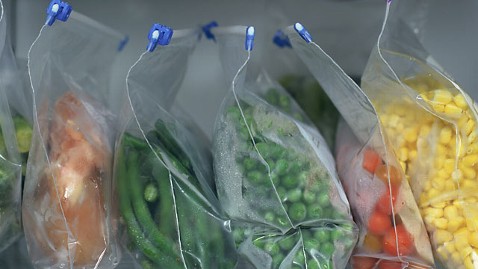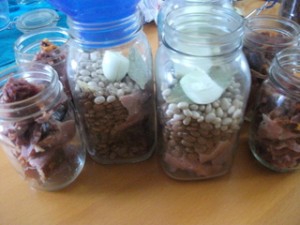If you're new here, you may want to subscribe to my RSS feed. Thanks for visiting!
It’s that time of year: your refrigerator is stuffed to the point that you have to lean against the door to close it and you never want to see another bite of turkey, ham, or roast beef again, let alone stuffing or green beans.
So what can a thrifty prepper do with all of that delicious bounty?
Preserve it!
Nearly all of your post-Christmas goodies can be put away for future use, adding to your stockpile. Don’t let anything go to waste. Many people wait too long to preserve the food and end up having to throw most of it in the trash.
I’ve published many of these after-holiday suggestions before, but for some readers this information will be all new. For those of you who have been around a long time, please share your own leftover preserving methods in the comments section!
Break Out the Dehydrator
If you have a dehydrator, you can put it to great use with your holiday leftovers. Dehydrated foods have several great benefits to your stockpile. First, they require no refrigeration and can happily reside in a jar in a cool dark place for several months. Second, they don’t require lengthy cooking time to prepare when it’s time to use them – boiling water is all it takes. And finally, because the removal of moisture causes the food to shrink, the reduced size means that you can store a lot more food in a lot less space.
If you don’t have a dehydrator, you can use a low heat in your oven, with the door slightly cracked to allow moisture to escape. If you’re new to dehydrating, you can find detailed instructions HERE, and you can use this handy rehydration chart for reconstituting the foods when it is time to use them.
- Dehydrate the remainder of your veggie tray. I find that veggies dehydrate very nicely when they are coarsely grated with the biggest holes in the cheese grater. Be sure and squeeze the excess moisture out with a paper towel to cut down on the drying time.
- Dehydrate leftover turkey or ham to be added to casseroles and soups.
- Leftover fruit can be pureed and then dehydrated into homemade fruit roll-ups.
- Dehydrate mashed potatoes, then run them through the blender for instant potato flakes. You can use these to thicken soups or gravies naturally.
- Dehydrate leftover stuffing, then rehydrate (“Stovetop Stuffing”-style) with broth when it’s time to serve it.
- Make homemade jerky with leftover meats.
Put It on Ice
Nearly all leftovers can be successfully frozen and used in other meals. For Tess Pennington’s guidelines on freezing food, click HERE.
Don’t be deterred if your veggies are in a sauce or highly seasoned. When an item is not particular appetizing in its original form, soups and casseroles made from combined freezer contents can be delicious. Check out this article about The Fine and Frugal Art of Repurposing Leftovers for more ideas.
- Freeze vegetables in cheese sauce to be used later in a pureed soup. Cheesy cauliflower and cheesy broccoli soup are big hits in our household. Simply thaw the veggies in cheese sauce and add to some white potatoes boiled in water. Thin the mixture down as desired with milk and serve piping hot.
- Freeze chopped meat mixed with gravy as the basis for a future speedy stew. If you want, you can also add cooked carrots and roasted potatoes to the mixture.
- Freeze leftover dinner rolls. You can reheat them as needed to use as rolls or you can dice them finely and freeze them for use in stuffing.
- Freeze desserts in individual servings for brown bag treats. They’ll be thawed out and delicious by lunch time.
- Freeze single servings of casseroles, lasagnas, etc. You’ll have the best lunches in the office!
- Puree cooked vegetables and freeze in ice cube trays. You can add a few cubes to casseroles and soups to up the nutritional value as well as the flavor.
And Canning…I Love Canning
Of course, I have to include my personal favorite preservation method, canning. Here are some links to specific instructions for putting away that ham and turkey.
- Can your ham leftovers and broth.
- Can homemade pork and beans with bits of leftover ham.
- Can your leftover turkey and broth.
- Can a soup made of broth, meat, and leftover veggies. (Click HERE to see how to can your own recipes.)
- Can some of your turkey and broth in the same manner as Chicken Needs Noodles Soup.
Waste Not, Want Not
Whatever methods that you use to preserve your leftovers, it can really help to offset the high cost of groceries that most of us face during the holiday season. You are behaving frugally by making that feast go further, which helps you in the short-term. More importantly, for the long-term, you are forming habits that allow you to keep food from going to waste, and one day these skills could help sustain your family through grim times.

















3 Responses
I froze the leftovers from Thanksgiving to use for our Christmas meal!
Do you know the difference between ziploc sealer bags and the silver bags that work with O2 absorbers? Is there an advantage one over the other and if so, what is it. Does on last longer and preserve the foods nutrients better than the other.
Do you know of a website that can inform me as to these details and the nutritional value of dehydrated, freeze dried, frozen and canned foods?
Dear Renee: There is a wealth of information here
http://readynutrition.com/resources/category/food-storage-preparedness/
Page after page of food storage information. Tess Pennington’s site Ready Nutrition has all of the answers you need. Use the search tool on the page – the silver bags you are referring to are called “Mylar” and they do preserve food really well. There are articles on that, as well as articles on desiccants and oxygen absorbers.
Best wishes –
Daisy